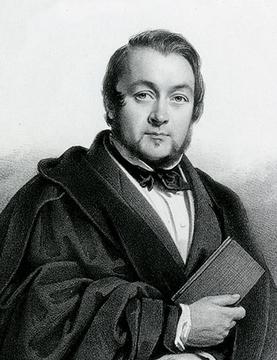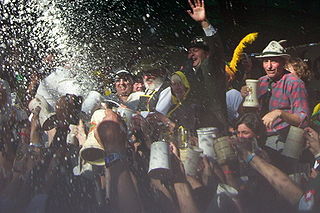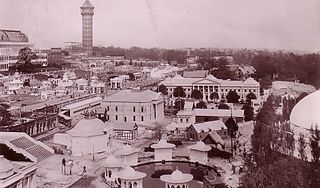
Munich is the capital and most populous city of the Free State of Bavaria, Germany. With a population of 1,594,632 inhabitants as of 31 May 2024, it is the third-largest city by population in Germany, after Berlin and Hamburg, and thus the largest which does not constitute its own state, as well as the 11th-largest city in the European Union. The Munich metropolitan area – including suburbs and satellite towns – has 3 million inhabitants; and the city's metropolitan region is home to about 6.2 million people and is the third largest metropolitan region by GDP in the European Union.

The Crystal Palace was a cast iron and plate glass structure, originally built in Hyde Park, London, to house the Great Exhibition of 1851. The exhibition took place from 1 May to 15 October 1851, and more than 14,000 exhibitors from around the world gathered in its 990,000-square-foot (92,000 m2) exhibition space to display examples of technology developed in the Industrial Revolution. Designed by Joseph Paxton, the Great Exhibition building was 1,851 feet (564 m) long, with an interior height of 128 feet (39 m), and was three times the size of St Paul's Cathedral.

The Great Exhibition of the Works of Industry of All Nations, also known as the Great Exhibition or the Crystal Palace Exhibition, was an international exhibition that took place in Hyde Park, London, from 1 May to 15 October 1851. It was the first in a series of world's fairs, exhibitions of culture and industry that became popular in the 19th century. The event was organised by Henry Cole and Prince Albert, husband of Victoria, Queen of the United Kingdom.
Crystal Palace may refer to:

Owen Jones was a British architect. A versatile architect and designer, he was also one of the most influential design theorists of the nineteenth century. He helped pioneer modern colour theory, and his theories on flat patterning and ornament still resonate with contemporary designers today.

A dirndl is a feminine dress which originated in German-speaking areas of the Alps. It is traditionally worn by women and girls in some Alpine regions of Austria, Germany, Italy, Liechtenstein and Switzerland. A dirndl consists of a close-fitting bodice with a low neckline, a blouse worn under the bodice, a wide high-waisted skirt and an apron.

Bavaria is the name given to a monumental, bronze sand-cast 19th-century statue in Munich, southern Germany. It is a female personification of the Bavarian homeland, and by extension its strength and glory.

Augustiner-Bräu is a brewery in Munich, Germany, established in 1328. It is Munich's oldest independent brewery.

Crystal Palace Park is a large park in south-east London, Grade II* listed on the Register of Historic Parks and Gardens. It was laid out in the 1850s as a pleasure ground, centred around the re-location of The Crystal Palace -- the largest glass building of the time -- from central London to this area on the border of Kent and Surrey; the suburb that grew around the park is known by the same name.

A beer festival is an event at which a variety of beers are available for purchase. There may be a theme, for instance beers from a particular area, or a particular brewing style such as winter ales.
Glass Palace may refer to:

The Oktoberfest is a two-week festival held each year in Munich, Germany during late September and early October. It is attended by six million people each year and has inspired numerous similar events using the name Oktoberfest in Germany and around the world, many of which were founded by German immigrants or their descendants.

Oktoberfest is the world's largest Volksfest, featuring a beer festival and a travelling carnival, and is held annually in Munich, Bavaria, from mid- or late-September to the first Sunday in October. The annual event attracts more than seven million international and national visitors at its peak. Locally, it is called d'Wiesn, after the colloquial name for the fairgrounds, Theresienwiese. Oktoberfest is an important part of local culture, having been held since the year 1810. Other cities across the world also hold Oktoberfest celebrations that are modeled after the original Munich event.

The Glaspalast was a glass and iron exhibition building located in the Old botanical garden in Munich modeled after the Crystal Palace in London. The Glaspalast opened for the first General German Industrial Exhibition on 15 July 1854.

New York Crystal Palace was an exhibition building constructed for the Exhibition of the Industry of All Nations in New York City in 1853, which was under the presidency of the mayor Jacob Aaron Westervelt. The building stood on a site behind the Croton Distributing Reservoir in what is now Bryant Park. It was destroyed by fire on October 5, 1858.

Therese Charlotte Luise of Saxony-Hildburghausen was queen of Bavaria as the wife of King Ludwig I. Oktoberfest was created in honour of their wedding and is still celebrated annually on Theresienwiese in Munich. Therese was popular amongst the people of Bavaria, and was heavily involved in her husband's politics, as well as her own charity work.

The 1911 Festival of Empire was the biggest single event held at The Crystal Palace in London since its opening. It opened on 12 May and was one of the events to celebrate the coronation of King George V. The original intention had been that Edward VII would open it in 1910, however, this was postponed after his death shortly before the planned opening day. The Festival contained a display of landscapes and exhibits from the British Empire, mainly the dominion countries, to encourage emigration to those nations; and it contained a large scale pageant dramatising British history. It was described at the time as 'a social gathering of the British family' encouraging the 'firmer welding of those invisible bonds which hold together the greatest empire the world has ever known'. It has since been described as the 'ultimate imperialist propaganda showcase'.

Gottlieb Daniel Paul Weber was a German artist. Weber is known for his ethereal and timeless landscape paintings of early northeast America. He emigrated to the U.S. in 1848 and though he returned to Germany around 1860 his influence on American landscape painting was still felt for years.

Seven cholera pandemics have occurred in the past 200 years, with the first pandemic originating in India in 1817. The seventh cholera pandemic is officially a current pandemic and has been ongoing since 1961, according to a World Health Organization factsheet in March 2022. Additionally, there have been many documented major local cholera outbreaks, such as a 1991–1994 outbreak in South America and, more recently, the 2016–2021 Yemen cholera outbreak.
Events from the year 1854 in Germany.


















